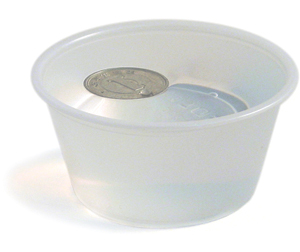May 27, 2010
 by: Tami O’Connor
by: Tami O’Connor
One of my all time favorite air pressure activities is an oldie and a goodie! It involves getting an egg into a classic, hard-to-find milk bottle, like the ones  delivered to grandma’s door. Unfortunately, some students (and some teachers) still think an egg can actually be sucked into a bottle. As you probably know because the air pressure is greater outside of the bottle than inside, the better explanation is that the egg is literally pushed into the milk bottle.
delivered to grandma’s door. Unfortunately, some students (and some teachers) still think an egg can actually be sucked into a bottle. As you probably know because the air pressure is greater outside of the bottle than inside, the better explanation is that the egg is literally pushed into the milk bottle.
Here is the explanation… The milk bottle and egg demo begins by placing two or three burning matches or a burning strip of paper into the empty bottle. Then a shelled, moistened hard-boiled egg is placed on the mouth of the bottle. The egg is clearly larger than the opening in the bottle. The air inside the bottle begins to heat up and subsequently expands. It is easy to notice the egg dancing around a bit as the air inside the bottle escapes around it.
Read the rest of this entry »
 3 Comments |
3 Comments |  Chemistry, Elementary level, experiments, High School level, Middle School level, Physics | Tagged: air pressure, discrepant event, egg in the bottle trick, milk bottle, PBL, phenomenon based learning, science demonstration |
Chemistry, Elementary level, experiments, High School level, Middle School level, Physics | Tagged: air pressure, discrepant event, egg in the bottle trick, milk bottle, PBL, phenomenon based learning, science demonstration |  Permalink
Permalink
 Posted by Tami O'Connor
Posted by Tami O'Connor
April 19, 2010
 by: Bennett M. Harris
by: Bennett M. Harris
It never fails. I get the same reaction, whether I present to seasoned physicists, grade level science teachers or even from the most discerning audience I’ve had; a group of fifty – fourth grade students, jaws gape and sounds of oohs, aahs and wows issue forth.
I’ve been in rooms surrounded by hundreds of artificial light sources, from the simplest incandescent bulbs to the most advanced OLED displays, and even so, when a person closes that knife switch and current begins to flow and a simple piece of pencil lead held suspended inside a partially evacuated chamber starts to glow brighter, brighter, and finally white light illuminates the chamber, something happens in the person’s brain. At once they are connected with the wonders that Sir Humphry Davy, Swan, and Edison felt when they experimented with the world’s first electrical light sources. Questions start to form; How does that work? How could we make it last longer? What would happen if we changed the carbon for some other material? All at once, the passive viewer is thinking scientifically, asking questions, and yearning to do more.
Read the rest of this entry »
 2 Comments |
2 Comments |  College level, energy, experiments, High School level, Middle School level, Physics | Tagged: awesome demonstration, build your own light bulb, electricity, experiments, incandescence, phenomenon based learning, reinventing Edison, science kit, Sir Humphry Davy, STEM, Thomas Edison, Tungsten filament |
College level, energy, experiments, High School level, Middle School level, Physics | Tagged: awesome demonstration, build your own light bulb, electricity, experiments, incandescence, phenomenon based learning, reinventing Edison, science kit, Sir Humphry Davy, STEM, Thomas Edison, Tungsten filament |  Permalink
Permalink
 Posted by Tami O'Connor
Posted by Tami O'Connor
April 2, 2010
 by: Ron Perkins
by: Ron Perkins
An eddy current is a current set up in a conductor in response to a changing magnetic field. Lenz’s law predicts that the current moves in such a way as to create a magnetic field opposing the change; to do this in a conductor, electrons swirl in a plane perpendicular to the changing magnetic field. Because the magnetic fields of the eddy currents oppose the magnetic field of the falling magnet; there is attraction between the two fields. Energy is converted into heat.
This principle is used in damping the oscillation of the lever arm of many mechanical balances. At the end of the arm a piece of flat aluminum is positioned to move through the magnetic field of a permanent magnet. The faster the arm oscillates, the greater the eddy currents and the greater the attraction to the permanent magnet. However, when the arm comes to rest, the attraction is negligible. Read the rest of this entry »
 Leave a Comment » |
Leave a Comment » |  College level, experiments, High School level, magnetism, Middle School level, Physics | Tagged: eddy currents, Lenz's Law, magnetic viewing film, neodymium magnet, phenomenon based learning |
College level, experiments, High School level, magnetism, Middle School level, Physics | Tagged: eddy currents, Lenz's Law, magnetic viewing film, neodymium magnet, phenomenon based learning |  Permalink
Permalink
 Posted by Tami O'Connor
Posted by Tami O'Connor
March 25, 2010
 by: Martin Sagendorf
by: Martin Sagendorf
Imagine students’ amazement when they actually see sunlight melt a penny with the Atomic Penny Vaporizer! This demonstration clearly illustrates the vast amount of energy illuminating the Earth’s surface. In rough numbers: 70% of the Sun’s incident energy on our outer atmosphere is reflected back into space – only about 30% actually gets to the Earth’s surface. But, as we experience, this is still a substantial quantity of energy.
Fortunately, this energy (I. R. – Visible – U. V.) is rather uniformly distributed over the Earth’s surface – thus its overall intensity is such that we have a habitable environment. However, as we all know, we can concentrate some ‘area’ of this energy to increase the ‘energy per area’ (a measure of this is the temperature of the area of concentrated energy). A common magnifying lens (2-4 in. diameter) will concentrate sufficient energy to burn paper or other objects with a low flash point. Read the rest of this entry »
 2 Comments |
2 Comments |  College level, energy, experiments, High School level, Middle School level, Physics | Tagged: Fresnel lens, how to build physics apparatus, melting zinc, phenomenon based learning, physics demonstration apparatus, STEM, sun's energy, thermal energy, vaporizing pennies |
College level, energy, experiments, High School level, Middle School level, Physics | Tagged: Fresnel lens, how to build physics apparatus, melting zinc, phenomenon based learning, physics demonstration apparatus, STEM, sun's energy, thermal energy, vaporizing pennies |  Permalink
Permalink
 Posted by Tami O'Connor
Posted by Tami O'Connor
February 24, 2010
 by: Ron Perkins
by: Ron Perkins
Who knew that a single coin could be used for so many classroom science activities! You can demonstrate concepts such as surface tension, buoyancy, and even eddy currents with Japanese yen coins!
Surface Tension: Even though aluminum has a density of 2.7 gm/cm3, and the density of water is 1 g/cm3, aluminum yen coins can float on the surface of the water!
Surface tension is a physical property of water. It is caused by cohesion, which is the attraction of like molecules. Water molecules are made up of two hydrogen atoms and one oxygen atom. The “stickiness” of water is caused by hydrogen bonding. This hydrogen bonding pulls the water molecules towards one another and forms a sort of “skin” on the surface of the water.
Japanese Yen Coins Experiment 1:
 Using a bent paper clip or a plastic fork, gently lower the flat side of the coin onto the surface of a pan or cup of water and remove the clip or fork. The coin should rest on the surface of the water. Read the rest of this entry »
Using a bent paper clip or a plastic fork, gently lower the flat side of the coin onto the surface of a pan or cup of water and remove the clip or fork. The coin should rest on the surface of the water. Read the rest of this entry »
 1 Comment |
1 Comment |  Chemistry, Elementary level, experiments, Middle School level | Tagged: buoyancy, density, eddy currents, floating, hydrogen bonding, parent friendly, phenomenon based learning, surface tension, variables, yen |
Chemistry, Elementary level, experiments, Middle School level | Tagged: buoyancy, density, eddy currents, floating, hydrogen bonding, parent friendly, phenomenon based learning, surface tension, variables, yen |  Permalink
Permalink
 Posted by Tami O'Connor
Posted by Tami O'Connor
 by: Tami O’Connor
by: Tami O’Connor delivered to grandma’s door. Unfortunately, some students (and some teachers) still think an egg can actually be sucked into a bottle. As you probably know because the air pressure is greater outside of the bottle than inside, the better explanation is that the egg is literally pushed into the milk bottle.
delivered to grandma’s door. Unfortunately, some students (and some teachers) still think an egg can actually be sucked into a bottle. As you probably know because the air pressure is greater outside of the bottle than inside, the better explanation is that the egg is literally pushed into the milk bottle.


 Posted by Tami O'Connor
Posted by Tami O'Connor  by: Bennett M. Harris
by: Bennett M. Harris
 by: Martin Sagendorf
by: Martin Sagendorf